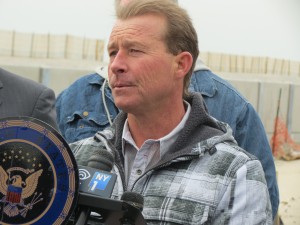
U.S. Sen. Chuck Schumer, center, Assemblyman Phil Goldfeder, second from left, and South Queens and Rockaway civic leaders gathered in Belle Harbor Monday to urge the U.S. Senate to pass legislation that aims to keep flood insurance rates affordable. Photo by Anna Gustafson
Facing massive spikes in flood insurance premiums that many said would drive people from their homes and neighborhoods, South Queens and Rockaway residents this week urged the U.S. Senate to greenlight legislation passed by the House of Representatives that they said would bring much needed financial relief to thousands of area residents still struggling financially after Hurricane Sandy.
“In Broad Channel, we were looking at premiums that raised $12,000 to $36,000 a year,” Broad Channel Civic Association President Dan Mundy, Jr. said at a press conference hosted by U.S. Sen. Chuck Schumer (D-NY) and Assemblyman Phil Goldfeder (D-Rockaway Park) in Belle Harbor on Monday.
The Homeowner Flood Insurance Affordability Act, which was sponsored by U.S. Rep. Michael Grimm (R-Staten Island) and passed the House by a vote of 306-91 last week, was expected to be voted on in the Senate this week. The bill aims to address a litany of problems stemming from the 2012 Biggert-Waters Act – a piece of legislation passed by Congress that aimed to make the debt-ridden National Flood Insurance Program, which was hemorrhaging money after Hurricane Katrina, more financially solvent by phasing out some subsidized insurance rates and allowing for rate increases of about 20 to 25 percent each year until properties reached actuarial status.
In other words, residents in South Queens – and in coastal communities across the country – were facing dramatic, and what many said were unaffordable, increases in flood insurance premiums that many legislators and civic leaders said would push people from their homes and deter others from purchasing the abandoned structures, leaving entire middle and working class neighborhoods to become ghost towns.

Broad Channel Civic Association President Dan Mundy, Jr. said residents in his South Queens neighborhood were facing flood insurance premium increases of as much as $36,000. Photo by Anna Gustafson
The increased premiums also came at a time when the Federal Emergency Management Agency was redrawing its flood maps – which insurance companies use to determine premium costs – and many South Queens residents who had not previously had to purchase insurance were faced with having to shell out thousands of dollars for it. Additionally, other residents who had previously been in flood zones found themselves mapped into even higher risk areas – which translates into greater insurance costs.
The federal legislation, which Schumer said he expected to easily pass the Senate, would place a cap on the annual rate hikes; remove the stipulation in the Biggert Waters Act that would have decimated home values by applying the new, higher rates to anyone purchasing a home in a high-risk flood zone; and repeal provisions of the law that forced drastic premium increases on homeowners that built to code and then were subsequently mapped into a higher risk area.
The Senate last month passed a more comprehensive flood insurance bill, which would have delayed all flood insurance increases until FEMA completed an affordability study, was not supported by the House.
“Coming right after Sandy, when people were just struggling to find the wherewithal to build their home back, this was just doubly insulting,” Schumer said of the rate hikes during Monday’s press conference.
Saying “there’s finally a light at the end of the tunnel,” Schumer said the new legislation will help to “keep these beautiful middle class communities middle class.”
“Is it everything we wanted?” Schumer continued in reference to the bill. “No. It is darn good? Yes.”
Goldfeder, whose own home was damaged in Sandy, lauded the legislation.
“Superstorm Sandy may have damaged thousands of homes in southern Queens and Rockaway, but skyrocketing flood insurance rates will wipe out our community and destroy any progress we’ve made over the past 17 months,” Goldfeder said.
Roger Gendron, president of the New Hamilton Beach Civic Association, also said that the rate increases would have “devastated communities.”
“The bigger battle wasn’t building back your home or cleaning your home, it was fighting the insurance companies,” Gendron said.
Specifically, the legislation, provided it passes the Senate and is approved by President Obama, will allow someone buying a home to be treated the same as the seller – meaning no policyholder will have to experience the rate shock of moving to full risk rates overnight.
The bill also reinstates the flood insurance program’s grandfathering provision, allowing homeowners that previously built to code under FEMA’s previous flood maps would not be hit with large increases if their new maps show a greater risk of flooding.
With the legislation, FEMA will also be required to complete an affordability study, which was mandated by the Biggert-Waters Act, that will be submitted to Congress for review.
Schumer and his Democratic colleagues in the Senate and House, including U.S. Rep. Gregory Meeks (D-Queens), worked to add a series of provisions to the House bill, including a stipulation that limits yearly premium increases to an average of 15 percent and a mandate that no individual policyholder pay an increase of more than 18 percent a year.
It also urges FEMA to attempt to allow most flood insurance policyholders to pay no more than 1 percent of the value of their insurance coverage for their premium – so, for example, $2,000 for a $200,000 policy.
By Anna Gustafson

No comments:
Post a Comment